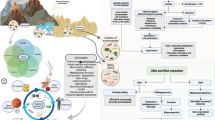Abstract.
Magnetotactic bacteria (MTB) are major constituents of natural microbial communities in sediments and chemically stratified water columns. The ability of MTB to migrate along magnetic field lines is based on specific intracellular structures, the magnetosomes, which, in most MTB, are nanometer-sized, membrane-bound magnetic particles consisting of the iron mineral magnetite (Fe3O4). A broad diversity of morphological forms has been found in various MTB. The unique characteristics of bacterial magnetosomes have attracted a broad interdisciplinary research interest. The magnetosome membrane (MM) in Magnetospirillum gryphiswaldense contains a number of specific Mam proteins. Several mam genes were analyzed and assigned to different genomic regions. Many of the Mam proteins are highly conserved in other MTB but display low sequence similarity to any proteins from nonmagnetic organisms.
Similar content being viewed by others
Author information
Authors and Affiliations
Additional information
Electronic Publication
Rights and permissions
About this article
Cite this article
Schüler, .D. The biomineralization of magnetosomes in Magnetospirillum gryphiswaldense . Int Microbiol 5, 209–214 (2002). https://doi.org/10.1007/s10123-002-0086-8
Received:
Accepted:
Issue Date:
DOI: https://doi.org/10.1007/s10123-002-0086-8




